Abermule is a village lying on the River Severn, some four miles northeast of Newtown, in the county of Montgomeryshire, along the A483 Swansea to Chester road. The Cambrian Line railway, connecting Aberystwyth to Shrewsbury, and the Montgomery Canal, close to the river, all pass through Abermule. The men of the village who fell during both World Wars are commemorated on a new war memorial, which replaced the original brass plaque, and is located outside the Abermule Community Centre. The memorial also commemorates the fallen of the nearby parishes of Llandysilio and Llanmerewig. Many thanks to Mary Mountford for sending me a photograph of the Abermule memorial, and also of some of the local war graves.
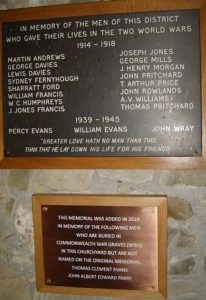
The Great War, 1914-1918
John Martin Andrew, Private, 9617, Worcestershire Regiment. John, known as Martin, was the son of John and Mary Andrew, of Camp, Berriew. He worked as a servant at Maesmawr Farm, Caersws prior to enlisting at Worcester into the Worcestershire Regiment at some time prior to the war. Martin embarked for France on 20 September 1914, as a draft for the 2nd Battalion, Worcestershire Regiment, which was attached to 5 Brigade, 2nd Division. The division had taken part in the Battle of Mons, and during the great retreat fought at the Affair of Landrecies, the Rear-guard Actions of Villers-Cotterets, and at the Battle of the Marne where the German offensive was stopped. The Germans retreated north, and the BEF advanced, fighting at the Battle of the Aisne. The 2nd Division was then moved to Flanders with the BEF, and fought at the First Battle of Ypres, where the German sweep through Flanders was stopped. The 2nd Division remained in Flanders throughout the first winter of the war. In 1915 the division took part in the Battle of Festubert, and in September fought at the Battle of Loos, and subsequent Action of Hohenzollern Redoubt. On 20 December 1915 the 2nd Worcester’s transferred to 100 Brigade of the newly arrived 33rd Division. The Division saw its first major action during the Battles of the Somme, from July 1916 onwards. The following year it moved north and fought at the Battle of the Scarpe and at Bullecourt, before heading to Ypres, and fighting at the Menin Road and at Polygon Wood. The division was still in Flanders when the German Spring Offensive hit on 9 April 1918, and the 2nd Worcester’s, in billets in Izel-les-Hameau, was summoned to the front, reaching the area of Caestre-Neuve Eglise on 11 April. On the following afternoon the battalion was attacked and saw heavy fighting over the coming days. John was killed in action during another German attack on 17 April 1918. The 33-year-old has no known grave and is commemorated on the Ploegsteert Memorial, Belgium.
George Ernest Davies, Sapper, 94841, Royal Engineers. George was the son of Evan and Elizabeth Davies, of Plasfoxen, Llandysilio. Prior to the war he was living with his wife, Edith Annie Davies, at Ismere, Witton Street, Stourbridge. George enlisted at Worcester into the Royal Engineers, and embarked for Gallipoli on 15 August 1915, landing at Gallipoli to join the SX Cable Section, Anzac Signal Depot. George would have worked in dangerous conditions, laying cables, which enabled communications from the Anzac HQs to the units in the front-line positions. George was wounded at the beginning of November 1915, and was evacuated to the beach at Embarkation Pier, where he died of his wounds on 10 November 1915, aged 28. He is buried in Embarkation Pier Cemetery, Gallipoli.
Lewis Davies, Private, 3118, Royal Welsh Fusiliers. Lewis was the son of Thomas and Elizabeth Davies of Bronllewelyn, Abermule. He worked as a waggoner for David Roberts, at Caecoedifor Farm prior to the war. Lewis enlisted into the 7th Battalion, Royal Welsh Fusiliers at Newtown. The battalion was a Territorial unit, which mobilised for war at Newtown in August 1914, as part of North Wales Brigade, Welsh Division and moved to Conway until the end of the month, before moving to Northampton. In December the Division moved to Cambridge and then in May 1915 to Bedford, where the Division was numbered and the formation became 158 Brigade, 53rd (Welsh) Division. On 19 July 1915 the entire Division sailed from Devonport for Imbros and on 9 August 1915 landed at Suvla Bay. The infantry moved off the beaches into the bush, but due to a lack of maps and no knowledge of the terrain, many of the units became disorientated, and the situation became chaotic. Lewis was wounded during the landings, and was evacuated by Hospital Ship to Hospital at Alexandria, where he died of his wounds on 17 August 1915, aged 28. He is buried in Alexandria (Chatby) Military and War Memorial Cemetery, Egypt.
Thomas Clement Evans, Private, 39150, South Wales Borderers. Thomas was the son of John Evans, of Abermule. He worked as a waggoner prior to the war. Thomas enlisted at Welshpool into the 3/1st Battalion, Montgomeryshire Yeomanry on 29 February 1916 and was posted to Park Hall Camp, Oswestry for training. On 30 August 1916 Thomas embarked for France, and on 7 September joined the 1st Battalion, South Wales Borderers, which was on the Somme attached to 3 Brigade, 1st Division. Thomas was wounded on the following day, while the battalion was fighting near High Wood, and was hospitalised, suffering from multiple gunshot wounds. He was discharged to No 5 Infantry Base Depot at Rouen at the end of the month, but his wounds must have affected his health, as Thomas was then transferred to the 33rd Prisoner of War Company at Bailleul, helping to guard German PoW’s. Thomas was sent home in 1917 and was posted to the 548th Agricultural Company, Labour Corps. He married Mary Ann Lloyd at Newtown on 16 February 1918, and the couple had two children, one born before their marriage. Thomas took ill after the end of the war, contracting influenza, and returned home, where he died of influenza on 14 February 1919, aged 35. He is buried in St. Llwchaiarn’s Churchyard, Llanmerewig. Thomas is not commemorated on the Abermule war memorial.
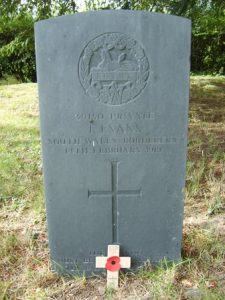
Sydney Fernyhough, Private, 838, Australian Infantry. Sydney was the son of Rowland Fernyhough and Annie Fernyhough (nee Ball), of Aberbechan Hall, Abermule. He had decided to emigrate to Australia and embarked at Liverpool aboard the White Star liner, SS Runic on 20 January 1912, before disembarking at Sydney. He found work as a labourer at Fremantle, but following the outbreak of war, felt the need to serve, and enlisted at Perth into the 44th Battalion, Australian Imperial Force on 18 January 1916. The 44th Battalion was raised at Claremont, Western Australia in February 1916 and joined the 11th Brigade, 3rd Australian Division. Sydney embarked with the battalion at Fremantle on 6 June 1916, and arrived in Plymouth on 21 July 1916. The Division then carried out further training before landing in France on 27 November and entered the front-line trenches of the Western Front for the first time on 29 December 1916. The battalion spent the bleak winter of 1916-17 alternating between service in the front line at Armentieres, and training and labouring in the rear areas. This routine was broken by only one major raid at Ploegsteert Wood, involving almost half the battalion on 13 March 1917. At 23.40, under cover of a rolling artillery barrage, the men advanced from Ploegsteert Wood and attempted to enter the German lines. As the Australians reached the barbed wire, the Germans launched a counter-barrage upon them, but nonetheless the men pressed on, only to be stopped when they came across a flooded ditch, and suffered heavy casualties before withdrawing. Sydney was badly wounded during the raid, being shot in the left shoulder, and was taken to the 11th Field Ambulance where he died of his wounds on 14 March 1917, aged 29. He is buried in Trois Abres Cemetery, Steenwerck, France.
Matthew Sharratt Ford, Corporal, 2595, Australian Machine Gun Corps. Matthew was the son of Alfred Ford, JP, and Fanny Ford (nee Williams), of Ivycot, Abermule. He decided to emigrate to Australia, embarking at London aboard the SS Omrah on 6 December 1912, and disembarked at Melbourne. Matthew then became a sheep shearer at Killarney, Coogee, New South Wales. He enlisted into the Australian Imperial Force at Liverpool, NSW on 16 May 1915, joining the 8th Reinforcements for the 3rd Battalion, AIF, and embarked at Sydney with the unit aboard HMAT Runic on 9 September 1915. The unit disembarked at Alexandria, after their voyage through the Suez Canal, and on 2 November 1915 Matthew was among a number of men sent as drafts to the 3rd Battalion at Gallipoli. The Gallipoli troops were evacuated soon afterwards, and Matthew went back to Alexandria with the 3rd Battalion, and on 12 March 1916 he was posted to the newly formed 1st Brigade Machine Gun Company. On 22 March 1916 his unit embarked for Marseilles, and moved with the 1st Australian Division to the Western Front, to positions near Armentieres. The Division was sent to the Somme in July, and saw heavy fighting at Pozieres and Mouquet Farm. Matthew was hospitalised in October, suffering from Scabies, re-joining his unit two weeks later. The 1st Division followed the German withdrawal to the Hindenburg Line in February 1917 and in April 1917 took part in the Battle of Bullecourt. Matthew was wounded at Bullecourt, being shot in the shoulder, and was evacuated to the 3rd Field Ambulance before being sent to No 3 Stationary Hospital at Rouen. On 20 April he was transferred to England and treated at the 1st Southern General Hospital. He then enjoyed two weeks leave before returning to duty, joining the Australian Depot at Weymouth on 29 May. On 26 June Matthew embarked at Folkestone for France and on 8 July re-joined his battalion in time to take part in the Passchendaele offensive. In February 1918 there was some re-organisation of units in France, and Matthew’s unit became part of the 1st Battalion, Australian Machine Gun Corps, still attached to the 1st Australian Division, which was near Merris, in Flanders. On 9 April 1918 the Germans launched the second phase of their Spring offensive in the area, and the Australians became caught up in desperate fighting near Merris. Matthew was killed in action here on 17 April 1918, aged 27. He is buried in Le Grand Hasard Military Cemetery, Morbecque, France.
Joseph Jones Francis, Private, M/287039, Royal Army Service Corps. Joseph was the son of David and Annie Francis of Lletty Maengwyn, Abermule. He worked as an Ironmonger’s Assistant prior to enlisting into the Army Service Corps at Welshpool on 5 June 1916, and was posted to the ASC Depot at Grove Park, where he learned to drive motor lorries. After completing his training, Joseph embarked for Salonika, and on 1 August 1917 joined the 779th Motor Transport Company, ASC. Joseph served in Salonika over the coming months, but by July 1918 his health had begun breaking down, and he was hospitalised. Joseph died of broncho-pneumonia and dysentery at the 42nd General Hospital, Salonika on 12 October 1918, aged 20. He was buried in Kirechkoi-Hortakoi Military Cemetery, Greece.
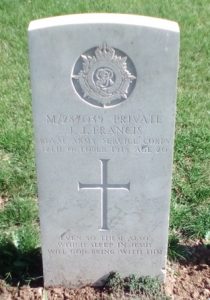
William Francis, Private, 2750, Manchester Regiment. William was the son of William and Elizabeth Francis, of Llandyssil. He had left the village to enlist into the 7th Dragoon Guards as a young man, but on 24 May 1900 deserted from their barracks at Aldershot. William then went to work in Manchester, and on 17 October 1908 married Harriett Helena Richards. The couple set up home at 55a, Chapman Street, Hulme, where William had found work as a dock labourer on the canals. He enlisted at Manchester into the Manchester Regiment soon after the outbreak of war, and with his previous military experience was posted to the 2nd Battalion, Manchester Regiment, embarking for France on 11 December 1914 to join the battalion, which was in Flanders attached to 14 Brigade, 5th Division. William joined up with the battalion at Neuve Eglise, near Ploegsteert. On 23 December the battalion took over trenches near Lindenhoek and Wulverghem, spending the first Christmas of the war in the front line, while the Christmas Truce was being held, immediately south at Ploegsteert. The battalion moved into rest billets at Bailleul at the beginning of January 1915, then on 10 January moved into flooded front-line positions at La Petite Douve Farm, beginning what would become the routine of trench rotation, several days in the line, followed by several days in support, then several in reserve. William was killed in action during a routine spell in the La Petit Douve Farm line on 14 March 1915. The 36-year-old has no known grave and is commemorated on the Ploegsteert Memorial, Belgium.
Wallace Gilbert Humphreys, Aircraftman 1st Class, 98264, Royal Air Force. Wallace was the son of Richard and Sarah Jane Humphreys, of Plantation Farm, Bolbro, Abermule. He married Tryphena Elizabeth Williamson 1 June 1914 and the couple set up home at 37, Commercial Street, Newtown. Wallace enlisted into the Royal Flying Corps on 3 October 1917 and was posted to France to serve with 8 Squadron. The Squadron had been in France since 15 April 1915, equipped with the B.E.2c, but it also operated a fighter flight equipped with a mixture of aircraft, including the B.E.8 and the Bristol Scout, based at airfields near Saint-Omer. The Squadron saw plenty of action throughout the war, and after the merger of the RFC and the RNAS to form the Royal Air Force, became attached to the Tank Corps, flying patrols in support of the Tank Corps attacks during the Battle of Amiens. In December 1918, after the Armistice, the Squadron re-equipped with Bristol F.2 Fighters. Wallace took ill after this, and he died of broncho-pneumonia at Charleroi on 20 February 1919, aged 30. Wallace is buried in Charleroi Communal Cemetery, Belgium.
Frank Jones, Private, 61311, Royal Welsh Fusiliers. Frank was the son of David and Elizabeth Jones, of Goronddu, Abermule. He worked as a farm labourer at Norton prior to the war. Frank enlisted into the Royal Welsh Fusiliers at Welshpool, and was sent to Kinmel Park for training. Frank was drafted to France early in 1917, and joined the 15th Battalion, Royal Welsh Fusiliers, which was in the Canal Bank sector at Boesinghe, attached to 113 Brigade, 38th (Welsh) Division. The infantry battalions of the Division had been carrying out the normal pattern of rotation in the trenches, four days in the front, four in support and four in reserve, whilst also working on trench improvement, digging new trenches, and also carrying out regular patrols and trench raids. On 31 July 1917 the Division launched its famous assault on the Pilckem Ridge, capturing Iron Cross and reaching its objective of the Steenbeek, then played a supporting role in the Battle of Langemarck. Heavy casualties were suffered by the Division during the initial assault, and the men were mixed up with other units, making the initial casualty role somewhat difficult, so various reports show that Frank was killed in action at some time between 31 July 1917 and 4 August 1917. He is officially commemorated as having been killed on 31 July. The 24-year-old is buried in Artillery Wood Cemetery, Belgium. Frank is not commemorated on the Abermule war memorial.
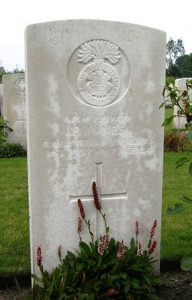
Lumley Owen Williams Jones, DSO, Brigadier General, Essex Regiment. Lumley was born in Cefn-Bryntalch, Llandyssil on 1 December 1876, the youngest son of Richard Edward Jones JP, DL, and Catherine Jones (nee Buckley Williams). He was educated at Clifton and then at Winchester College, and after leaving Winchester was commissioned from the Militia into the 2nd Battalion, Essex Regiment. By 1912 he had been appointed Captain and became the Adjutant to the battalion, and embarked for France with the battalion on 22 August 1914, joining the BEF. He fought through all the earlier actions of the war, and shortly before the Second Battle of Ypres was appointed to the command of the battalion. The battalion performed well during Second Ypres, and was specifically mentioned in Lord French’s Despatches as having twice saved the line. Lumley was afterwards promoted to Brigadier General and placed in charge of the 13th Infantry Brigade, of the 5th Division, which performed well during the Battle of Vimy Ridge. Late in 1917, the Division was ordered to move to Italy and reinforced the Italian front, but had been moved back to France by the time the Germans launched their great Spring offensive of 21 March 1918. Lumley’s Brigade saw much fighting in the ensuing period, and then from 21 August 1918 took part in the great Allied offensive which ultimately won the war. Early in September 1918, Lumley contracted influenza, and his health failed rapidly before he died of pneumonia at Bagneux on 14 September 1918, aged 41. He was buried with full military honours in Bagneux British Cemetery, Gézaincourt, France. Lumley had a conspicuous career, having been awarded the Distinguished Service Order, the French Legion D’Honneur, the Order of St. Maurizio and St. Lazarus, and was seven times mentioned in Despatches. He was the last of twelve British General’s to die during the war. His elder brother, Edward Whitmore Jones, had commanded the 2nd Battalion, South Wales Borderers. For some reason not obvious to the writer, Lumley is not commemorated on the Abermule war memorial.
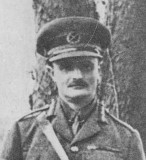
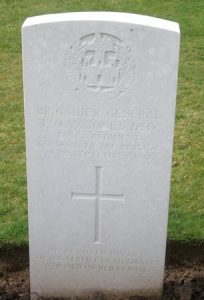
William Joseph Jones, Private, 49834, North Staffordshire Regiment. William was the son of John and Annie Jones, of Green Lane Cottage, Abermule. He had served in the army prior to the war, and as an army reservist was recalled to the colours, re-enlisting at Caersws on 11 October 1915 into the 5th Reserve Cavalry Regiment. William was then placed back onto the army reserve, and was not mobilised until 1 May 1917, when he joined the 5th Reserve Cavalry Depot at Bristol. On 3 September 1917 William was transferred to the 3rd Battalion, North Staffordshire Regiment at Wallsend, and on 17 October 1917 he embarked for France, joining the 9th Battalion, North Staffordshire Regiment, which was attached to the 37th Division, as the Divisional Pioneer battalion. William joined the battalion in the Ypres Salient, where it was based at Vierstraat, supplying working parties at Shrewsbury Forest, Fusilier Wood, Battle Wood and Hollebeke, supporting the Passchendaele offensive. On 10 January 1918 the Division moved out of the Ypres Salient, and moved to billets in various locations north-west of Aire to rest and rebuild, before moving back into the salient at the end of the month, to positions near Dickebusch, and the 9th North Staffs began work in locations at Zillebeke, the Menin Road and at Gheluvelt. The Germans launched their massive Spring offensive to the South on 21 March 1918, along the section of front line running from Croisilles to La Fère, and the Allies crumbled in the face of the onslaught. The 37th Division was rushed south, leaving the salient on 29 March, and entrained at Poperinghe for Doullens. The Division took over a section of front line between Gommecourt and Hébuterne, while the 9th North Staffs took over dugouts at Foncquevillers before beginning work consolidating the new front line. William was with a working party extending a trench line on 10 April when he was shot in the chest and was taken to the 49th Field Ambulance for treatment. He died of his wounds there on 12 April 1918, aged 25. William is buried in Doullens Communal Cemetery Extension No. 1, Somme, France.
George Matthew Mills, Private, 290991, Royal Welsh Fusiliers. George was the son of Frank and Mary Mills, of Brook Cottage, Abermule. He worked as a waggoner prior to marrying Mary Elizabeth Richards in 1911, and the couple set up home at Dingle Cottage, Abermule. He then found work as a roadman. George had already served for three years with the Montgomeryshire Yeomanry Territorials when he enlisted into the 7th Battalion, Royal Welsh Fusiliers at Newtown on 8 March 1915. The battalion was also a Territorial unit, which mobilised for war at Newtown in August 1914, as part of North Wales Brigade, Welsh Division and moved to Conway until the end of the month, before moving to Northampton. In December the Division moved to Cambridge and then in May 1915 to Bedford, where the Division was numbered and the formation became 158 Brigade, 53rd (Welsh) Division. On 19 July 1915 the entire Division sailed from Devonport for Imbros and on 9 August 1915 landed at Suvla Bay. The infantry moved off the beaches into the bush, but due to a lack of maps and no knowledge of the terrain, many of the units became disorientated, and the situation became chaotic. The Division was eventually evacuated from Gallipoli in December 1915, moving to Egypt to join the EEF, and helped guard the Suez Canal before taking part in operations to drive the Turks out of the Sinai. The EEF then turned its attention onto driving the Turks out of Palestine, and on 26 March 1917 launched its first offensive against the coastal city of Gaza, which guarded the road to Jerusalem. Initial gains during the day were lost when the assaulting divisions lost touch with each other and communication broke down when a thick fog cloaked the battlefield. George was posted as missing during the fighting of 26 March, but was later officially accepted as having been killed on that date. The 30-year-old has no known grave and is commemorated on the Jerusalem Memorial, Israel.
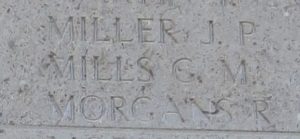
John Henry Morgan, Private, 55525, Royal Welsh Fusiliers. John was the son of John and Sarah Morgan of Penybryn, Abermule. He enlisted at Welshpool into the Montgomeryshire Yeomanry, and was posted to Park Hall Camp, Oswestry for training. John probably embarked for France in the Spring of 1917, and was posted to the 17th Battalion, Royal Welsh Fusiliers, which was holding the Canal Bank sector at Boesinghe, attached to 115 Brigade, 38th (Welsh) Division. The Division had moved there following its epic assault on Mametz Wood the previous year, and its infantry battalions had been carrying out the normal pattern of rotation in the trenches, four days in the front, four in support and four in reserve, whilst also working on trench improvement, digging new trenches, and also carrying out regular patrols and trench raids. On 31 July 1917 the Division launched its famous assault on the Pilckem Ridge, capturing Iron Cross and reaching its objective of the Steenbeek, then played a supporting role in the Battle of Langemarck. The Division was transferred to the Sailly-sur-la-Lys sector in September, and remained in the area over the winter. On 1 March 1918 the 17th RWF relieved the 2nd RWF to begin another routine tour in the Wez Macquart Sector, and on the following day launched a trench raid against the Germans, suffering thirteen men wounded. The battalion remained in the front line over the coming days, with working parties busy repairing and improving the trenches. John was killed in action here on 6 March 1918, aged 20. He is buried in Erquinghem-Lys Churchyard Extension, France.
John Albert Edward Parry, Private, 1911, Montgomeryshire Yeomanry. John was the son of Edward and Jane Parry, of Llandysilio. He worked as an ironmonger prior to the war and had enlisted at Newtown into the Montgomeryshire Yeomanry on 20 February 1913. John had then served in two annual TA summer camps, at Llandeilo and Tywyn, prior to the outbreak of war. John was mobilised on 5 August 1914, but two days later he was discharged from the regiment. John returned home, and married Mary Lewis at Berriew on 1 March 1916, giving his occupation as farmer. John appears to have continued to farm over the coming years, until his death on 9 September 1920, aged 26. He was buried four days later in St. Llwchaiarn’s Churchyard, Llanmerewig. John is not commemorated on the Abermule war memorial.
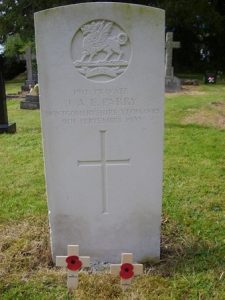
John Edward Pritchard, Lance Sergeant, 355302, Royal Welsh Fusiliers. John was the son of William and Elizabeth Pritchard of Dingle Cottage, Abermule. He enlisted into the 1/1st Battalion, Montgomeryshire Yeomanry at Welshpool on 28 September 1914. On 5 August 1914 the Montgomeryshire Yeomanry had mobilised at Welshpool, as part of the South Wales Mounted Brigade, before moving via Hereford to Thetford, to join the 1st Mounted Division. On 4 March 1916 the 1st Mounted Division sailed for Egypt to join the EEF. On 4 March 1917 the battalion merged with the Welsh Horse Yeomanry to form the 25th (Montgomery & Welsh Horse Yeomanry) Battalion, Royal Welsh Fusiliers, as part of the newly formed 231 Brigade, 74th (Yeomanry) Division. The Division did not take part in the disastrous First Battle of Gaza, as it was not ready, but took part in the second attempt to take the coastal city, which was launched on 17 April 1917, but also failed, and the EEF suffered a change in leadership, with Sir Edmund Allenby assuming command, before being re-organised, and a third offensive was launched against a wider front from Beersheba to Gaza on 31 October 1917. This time the Turkish defences were breached, and the road to Jerusalem now lay open. John was killed in action during this successful Third Battle of Gaza, on 31 October 1917. The 27-year-old is buried in Beersheba War Cemetery, Israel.
Thomas Edward Pritchard, Private, 3507, Royal Welsh Fusiliers. Thomas was the son of Thomas and Ann Pritchard, of 2, Road Cottages, Llanmerewig. By 1911 his parents had moved to 6, Powell’s Row, Welshpool, while Thomas was living and working as a waggoner at Middle Sylfaen, Castle Caereinion. Thomas enlisted into the 7th Battalion, Royal Welsh Fusiliers at Welshpool soon after the outbreak of war. The battalion was a Territorial unit, which mobilised for war at Newtown in August 1914, as part of North Wales Brigade, Welsh Division and moved to Conway until the end of the month, before moving to Northampton. In December the Division moved to Cambridge and then in May 1915 to Bedford, where the Division was numbered and the formation became 158 Brigade, 53rd (Welsh) Division. On 19 July 1915 the entire Division sailed from Devonport for Imbros and on 9 August 1915 landed at Suvla Bay. The infantry moved off the beaches into the bush, but due to a lack of maps and no knowledge of the terrain, many of the units became disorientated, and the situation became chaotic. Heavy fighting raged over the coming days, before the Gallipoli campaign bogged down into a stalemate, and as winter neared sickness and disease was rife. Thomas was wounded towards the end of the campaign, and died of his wounds at the 2nd Welsh Field Ambulance, Gallipoli on 29 November 1915, aged 26. He is buried in Lala Baba Cemetery, Gallipoli.
John Morris Rowlands, Private, 808318, Canadian Infantry. John was born in Ystrad, Rhondda on 16 August 1890, the son of John and Ann Rowlands. The family later resided at Freestone Rock, Llanllwchaiarn. John had emigrated to Canada prior to 1909, and married Mary Lavinia Bramwell, of Michigan. The couple lived at 1108, 7th Avenue, West Calgary, Alberta, where John worked as a miner. He enlisted into the Canadian Infantry at Drumhella, Alberta on 27 January 1916 and embarked for England from Halifax with the 137th Overseas Battalion, Canadian Infantry on 22 August 1916. The battalion disembarked at Liverpool before entraining for the Canadian camp at Withey, for further training. On 29 November 1916 John landed in France, and was posted to the 31st Battalion, Canadian Infantry, which was attached to the 6th Brigade, 2nd Canadian Division. John would have arrived in time to take part in the latter stages of the Somme offensive, and in the Spring of 1917 would have taken part in the Battle of Vimy Ridge. John was wounded on 29 July 1917, but remained at duty, taking part in the Battle of Passchendaele, and on 22 November was awarded two weeks leave, returning to England to see his wife Mary, who had left Canada to live in 34, Enville Street, Ashton-under-Lyne, with their daughter, Anna. He re-joined the battalion in France, and would have taken part in the great Canadian victory at Villers-Bretonneux on 8 August 1918, before the launching of the great Allied offensive, which won the war, on 21 August 1918. John survived the war, and came home on leave, but took ill and died of influenza at the Military Hospital, Endell Street, London on 3 December 1918, aged 36. He is buried in Brookwood Military Cemetery, Surrey.
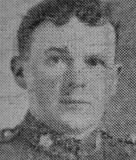
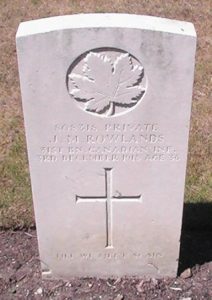
Albert Victor Williams, Motor Mechanic, MB/2926, Royal Naval Volunteer Reserve. Albert was born on 21 June 1897, the son of Edward Benjamin and Mary Jane Williams of The School House, Abermule. He enlisted into the Royal Naval Volunteer Reserve on 4 June 1918, and was appointed as a Motor Mechanic before being posted to the protected-cruiser HMS Hermione, which was a guard ship at Southampton, which had later become the HQ Ship for motor launches and coastal motor boats operating from Southampton from December 1916 until December 1919. Albert was posted to HMS Victory X on 26 August 1918, and was demobilised from there on 23 February 1919. His health had by now begun to suffer, and he was diagnosed as suffering from tuberculosis. Albert had gone to live at Bangor, and married Margaret Irving Kerr, of Dinwoodie, Bangor, prior to being demobilised. His health continued to break down over the coming months, and Albert eventually died of tuberculosis at Brynseiont Hospital, Caernarvon on 16 August 1920, aged 24. His remains were brought home for burial in St. Llwchaiarn’s Churchyard, Llanmerewig.
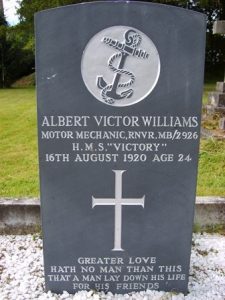
Second World War, 1939-1945
Percy Llewellyn Leonard Evans, Sapper, 4194872, Royal Engineers. Percy was the son of John Evans and Hannah Evans (nee Austin), of Kerry. He enlisted into the Royal Engineers and was posted to the 159th Railway Construction Company, RE. He was in France with the BEF in 1940. Following the German Blitzkrieg, the various elements of the BEF, as well as countless civilians, had been forced to withdraw to the French coast for evacuation. The thousands of troops who had made it to Dunkirk had already been evacuated by 6 June, whilst more had been evacuated from Boulogne, Calais and Le Havre by 25 May. More Allied troops had managed to reach ports in other parts of France, stretching from Cherbourg down to Bayonne, so the British organised Operation Aerial, to evacuate Allied forces and civilians from western France. Percy had managed to reach St. Nazaire with most of his company. On 17 June 1940 the requisitioned RMS Lancastria steamed into the Loire Estuary and anchored in the Charpentier Sounds. By the afternoon Lancastria had taken aboard a huge number of evacuees, far greater than she was built to carry, with estimates running from 4,000 to 9,000 people. The Germans had already begun attacking shipping in the area, and at 15.50 Lancastria was attacked by Junkers-88 bombers and sank in less than 20 minutes. An estimated 6,500 people drowned in the sinking of Lancastria that day. Percy was 26-years-old when he was lost in the sinking of the Lancastria. He has no known grave and is commemorated on the Dunkirk Memorial, France.

William Thomas Evans, Flying Officer, 165531, Royal Air Force. William was born on 2 May 1924, the son of Abraham Evans and Mary Ann Evans (nee Corfield) of The Hollies, Llandyssil. William enlisted into the Royal Air Force, and after training as a Navigator and Bomb Aimer, was posted to 251 Squadron, RAF, which was based at Reykjavik, Iceland, and was an Air/Sea Rescue and Meteorological unit, equipped with the Lockheed Hudson. On 17 March 1945, William took off from Reykjavik aboard Hudson FK739, which had been detailed to carry out a meteorological reconnaissance in the North Atlantic Ocean. The aircraft remained in contact with base for the early hours of the sortie, but on the return flight shortly after dawn, all communication was lost. Aircraft were despatched to search for the Hudson, but no trace was ever found, and it was presumed lost at sea. William was 20 years old when he lost his life on 17 March 1945. He has no known grave and is commemorated on the Runnymede Memorial, Surrey.
John Wray, Private, 6979739, Argyll and Sutherland Highlanders. John was born in Donegal in 1912. He enlisted into the army and whilst based in Mid Wales met and married Winifred May Richards, of Llanmerewig in 1940. John served with the 1st Battalion, Argyll And Sutherland Highlanders, which was attached to the 16th Infantry Brigade. The battalion moved to North Africa in 1940, and took part in the campaign in the Western Desert. On 17 May 1941 the battalion moved to Crete, and took part in the heavy fighting which followed when the island was invaded by German paratroopers, before being evacuated on 29 May from Heraklion. The survivors landed in Alexandria and were placed on garrison duties before launching a raid into Abyssinia, and the battalion was then sent back to the Western Desert to join the 161st Indian Infantry Brigade, 4th Indian Infantry Division, before taking part in the Second Battle of El Alamein. In 1943 the 1st Battalion landed on Sicily during Operation Husky, the Allied invasion of Sicily, attached to the 5th British Infantry Division. In February 1944 the battalion landed on mainland Italy and fought through the Italian Campaign with the 19th Indian Infantry Brigade, 8th Indian Infantry Division. John was killed in Italy on 6 October 1944, aged 32, and is buried in Faenza War Cemetery, Italy. His widow, Winifred, died on 30 December 1983.